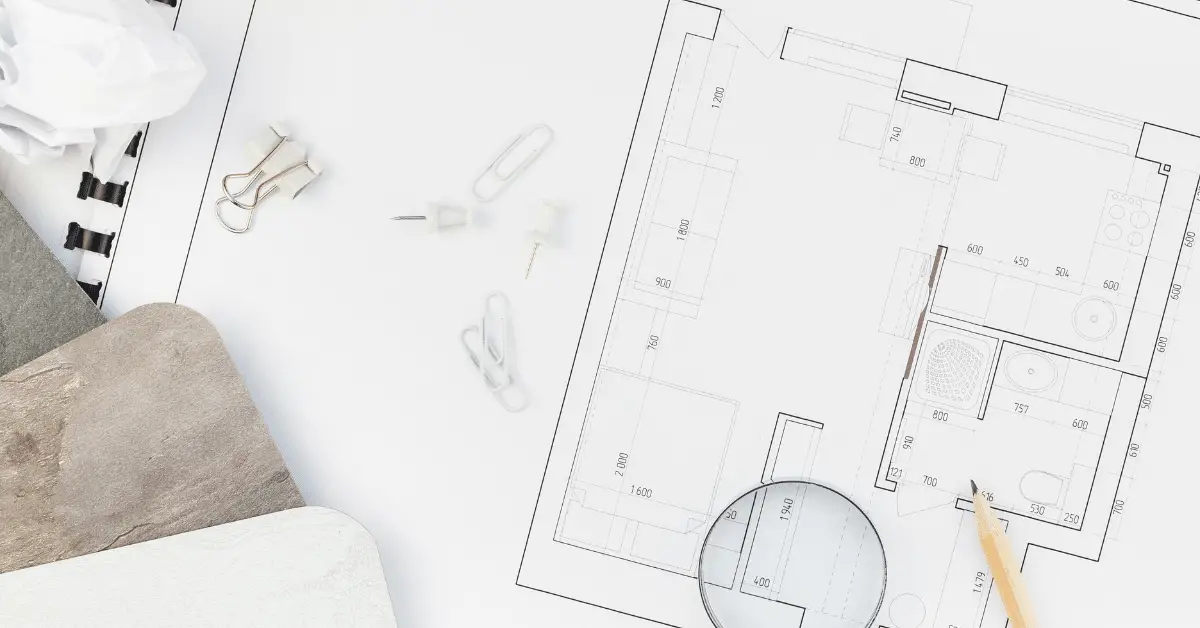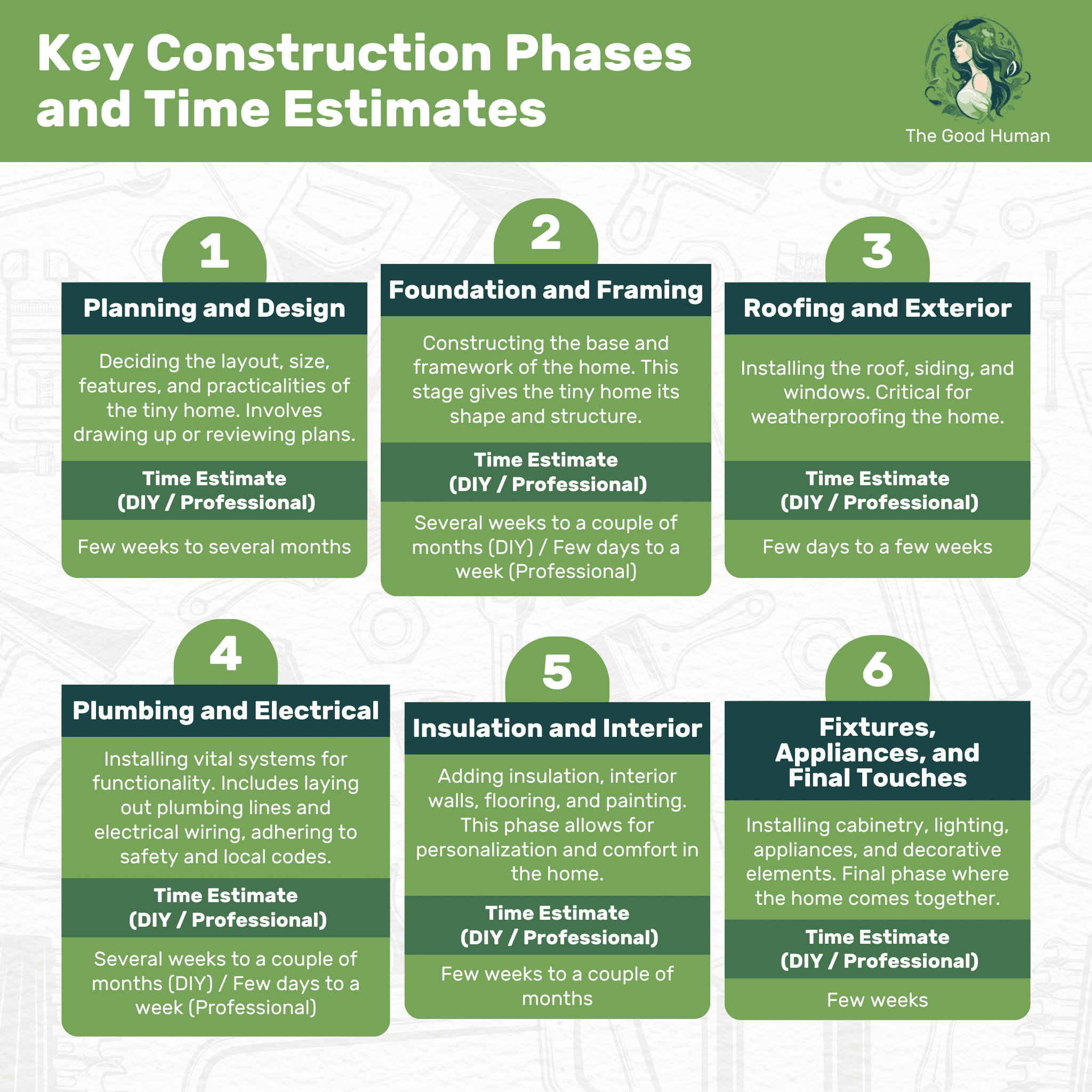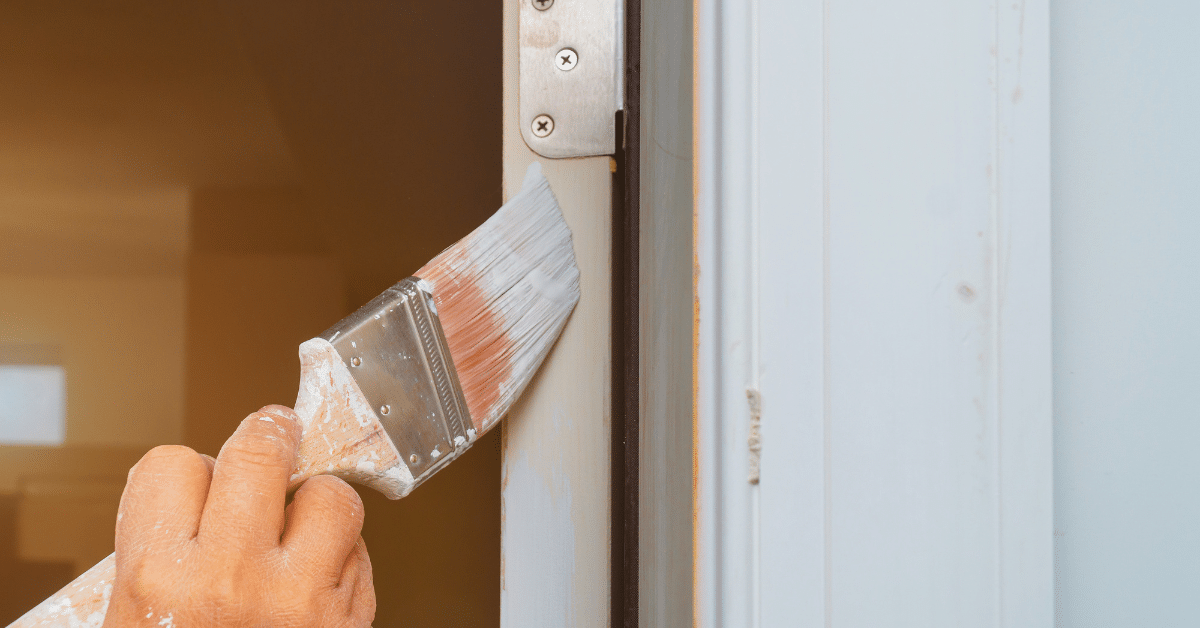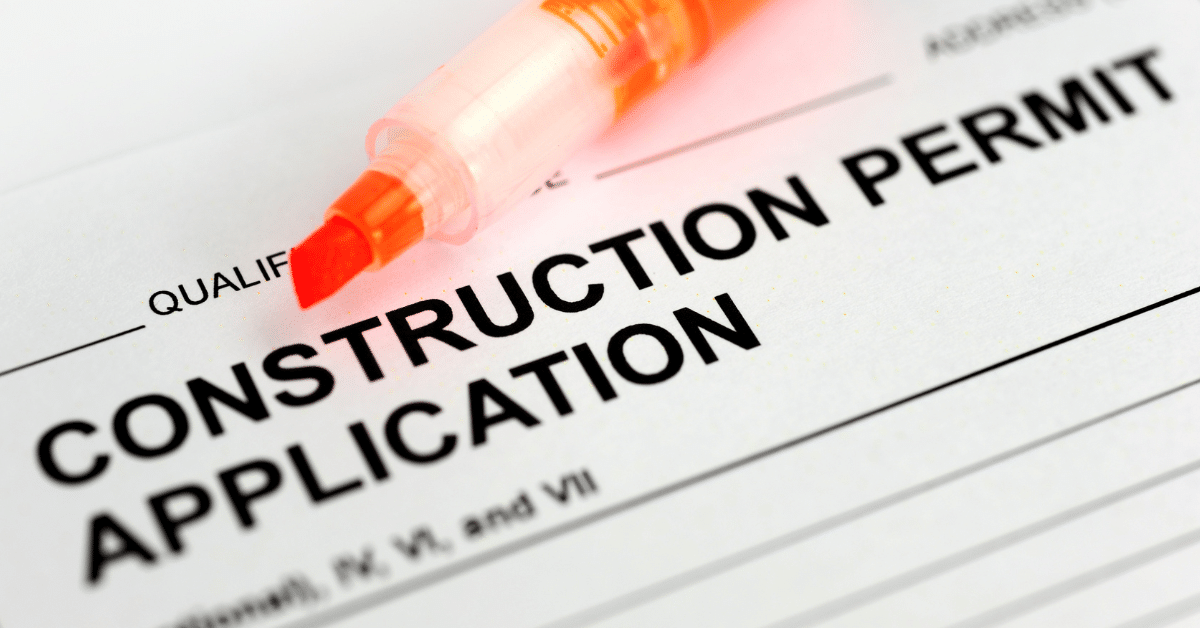How long would it take to build a tiny home? This is a question on the minds of many who are considering a shift towards a simpler, more sustainable lifestyle. Whether you’re a person planning for self-sufficiency or someone intrigued by the tiny living movement, understanding the time commitment involved in building a tiny home is crucial.
Building a tiny home can range from several months to over a year for DIY builders, while professionals might complete it more quickly. Time estimates vary based on factors like design complexity, skill level, and material availability, encompassing planning, framing, roofing, plumbing, and finishing touches.
Read on for a detailed breakdown of the construction stages, from the initial planning and design to the final installation of fixtures and appliances. We’ll provide insights into the time estimates for each phase, both for DIY enthusiasts and those considering professional help, helping you map out your tiny home journey with greater clarity and confidence.
Factors Influencing Construction Time
The journey of building a tiny home is not just about creating a living space; it’s about crafting a lifestyle. Several key factors can significantly influence the time it takes to complete your tiny home.
DIY vs. Professional Builders
When it comes to building a tiny home, one of the first decisions you’ll face is whether to take on the project yourself or hire professional builders. As a DIYer, the process can be a fulfilling but time-consuming endeavor. Professionals, on the other hand, bring efficiency and expertise, potentially speeding up the construction timeline. However, balancing your personal involvement with professional help can offer a middle ground, combining the satisfaction of DIY with the proficiency of experts.
While it’s tempting to tackle every aspect of building yourself, remember that professionals can handle complex tasks like electrical wiring and plumbing more swiftly and safely. This approach not only ensures quality but also adheres to building codes, which can be particularly intricate in tiny home construction. But, be mindful of scheduling and coordination, as relying on external contractors can introduce delays if not managed properly.
Skill and Experience Level
Your skill and experience level in various construction domains will greatly impact your building timeline. If you’re a novice in areas like structural engineering or roofing, prepare for a steep learning curve. This journey is not just about hammering nails; it’s about acquiring a broad skill set, from framing to finishing touches.
Even if you’re handy, first-time projects always take longer. If you’re experienced in general construction but new to tiny home specifics, allocate time for learning and adapting. It’s crucial to be realistic about your abilities and the learning time required, which can stretch your project timeline.
Planning and Design

The foundation of a successful tiny home project lies in thorough planning and design. This phase determines not just the aesthetics but also the functionality and feasibility of your tiny home. Whether you’re drawing up plans yourself, working with an architect, or customizing pre-made plans, this stage requires careful consideration and time.
Planning isn’t just about blueprints; it’s about envisioning your living space and ensuring every inch is optimized for your needs. Take the time to ponder over your design, considering aspects like storage, mobility, and living comforts. Remember, changes made on paper are far easier and less costly than those made during construction.
Key Construction Phases and Time Estimates
Building a tiny home is like composing a symphony, where each phase plays a crucial role in the overall harmony. Let’s break down this process into its major components and understand the time each phase might take.

Planning and Design
The planning and design phase is the blueprint of your tiny home project. This phase involves deciding the layout, size, and features of your home. It’s where you determine the practicalities of your living space, including storage solutions, sleeping areas, and utilities like plumbing and electrical systems. This phase can take anywhere from a few weeks to several months, depending on the complexity of your design and your decision-making process.
It’s important to spend adequate time in this phase to avoid costly changes later. If you’re designing the plans yourself, allow time for research and learning. If you’re working with an architect or buying pre-made plans, the process might be quicker but will still require your input and review.
Foundation and Framing
The foundation and framing stage is where your tiny home starts to take shape. This phase involves constructing the base of your home and erecting the framework that defines its shape and structure. For a DIY builder, this can take several weeks to a couple of months. In contrast, professionals might complete it in a few days to a week, depending on the complexity and size of your tiny home.
During this phase, accuracy and precision are crucial. Mistakes made in framing can have significant implications for the rest of the build. This is also the phase where weather conditions can play a significant role, potentially causing delays.
Roofing and Exterior
Once the framing is complete, the next step is roofing and working on the exterior, including siding and windows. This phase is critical for weatherproofing your home and can take anywhere from a few days to a few weeks. For DIY builders, learning the skills required for roofing and exterior work can add to the time required.
Professional help can expedite this phase, ensuring that the house is weatherproof and secure in a shorter time. This phase is also sensitive to weather conditions, so planning according to the forecast is important.
Plumbing and Electrical
The plumbing and electrical phase involves installing the vital systems that make your tiny home functional. For a DIYer, this phase can be particularly challenging and time-consuming, potentially taking several weeks to a couple of months, especially if you’re learning as you go. It’s crucial to prioritize safety and compliance with local codes in this phase.
Professional assistance is often sought for this phase due to the complexity and risk involved, especially with electrical work. Hiring a professional can reduce the time to a few days to a week but will require coordination and scheduling.
Insulation and Interior Finishing

Insulation and interior finishing give your tiny home its personality and comfort. This phase includes installing insulation, interior walls, flooring, and painting. For a DIY builder, expect this phase to take a few weeks to a couple of months, depending on the level of detail and customization you desire.
This phase allows for creativity and personalization, so it’s a time where many builders enjoy putting their unique touches on their homes. The time required can vary greatly based on the materials used and the complexity of the interior design.
Fixtures, Appliances, and Final Touches
The final phase of building a tiny home is installing fixtures, appliances, and adding the finishing touches. This includes cabinetry, lighting, appliances, and decorative elements. This phase can take a few weeks for a DIY builder, as it involves a lot of detailed and often delicate work.
Professional help can speed up this process, but personal involvement in the finishing touches can make your tiny home truly feel like yours. This phase is where the project really comes together, and you see the fruition of your hard work.
Common Challenges and Time Delays
Every construction project has its hurdles, and building a tiny home is no exception. Anticipating and preparing for these challenges can help keep your project on track.
Unexpected Runs to Hardware Stores
One of the most common yet overlooked aspects of building a tiny home is the frequency of trips to the hardware store. These trips, although seeming minor, can significantly impact your construction schedule. You might find yourself needing additional materials or specific tools that weren’t on your original list. To minimize this disruption, it’s beneficial to plan your purchases meticulously, considering potential needs and contingencies.
A good strategy is to compile a comprehensive list of materials and tools required for each phase of construction. Consider buying in bulk where possible to reduce the number of trips. Organizing and staging your materials at the worksite can also save time. Remember, each trip to the store is time away from actual construction, so efficient planning in this area is key to maintaining momentum.
Weather Conditions
Weather can play a significant and unpredictable role in the timeline of building a tiny home. Adverse weather conditions like rain, snow, or extreme heat can halt construction activities, especially during phases that require outdoor work. Planning your construction schedule with a weather-aware approach is crucial to avoid unnecessary delays.
To mitigate weather-related delays, monitor weather forecasts regularly and plan your activities accordingly. Whenever possible, set up covered or indoor workspaces for tasks that can be affected by weather. Preparing for these eventualities can keep your project on track, ensuring that a rainy day doesn’t turn into a construction standstill.
Permit and Regulation Challenges

Navigating the maze of permits and regulations is a critical aspect of building a tiny home. These requirements can vary widely and are often complex, potentially causing significant delays if not handled properly. Early research into local building codes and zoning regulations can save you from future headaches.
Consulting with local authorities or professionals experienced in tiny house construction can provide clarity and guidance. Ensure that you have all necessary approvals and permits before starting construction to avoid legal complications. This proactive approach can help smooth out the bureaucratic process and keep your project on schedule.
Tips for Efficiency and Time-Saving
Building a tiny home efficiently requires smart planning and strategic decision-making. Let’s explore some tips that can save you time and effort in your building journey.
Strategic Planning
Effective strategic planning goes beyond creating a construction schedule. It involves anticipating potential challenges and preparing solutions in advance. This includes ordering materials ahead of time, logically scheduling work phases, and ensuring access to necessary tools and skills.
A well-thought-out plan should account for every aspect of the construction process, from foundation to finishing touches. This includes setting realistic goals, allocating time for learning new skills, and adapting to unforeseen challenges. A strategic approach can significantly reduce overall build time and enhance the efficiency of your tiny home project.
Utilizing Pre-built Components
Incorporating pre-built components like tiny house shells or panel homes can drastically reduce construction time. These prefabricated elements provide a foundational structure, allowing you to focus on customization and interior finishing. This method is not only time-efficient but also ensures professional craftsmanship and structural integrity.
Opting for pre-built components doesn’t mean sacrificing uniqueness or personal touch. These elements can be customized to fit your specific needs and style preferences. By streamlining the initial construction phases, you can dedicate more time to personalizing your tiny home.
Dealing with Burnout
The process of building a tiny home can be both physically and mentally demanding, especially for DIY builders. To prevent burnout, it’s essential to pace your work and take regular breaks. Setting manageable goals and celebrating small achievements can help maintain motivation throughout the project.
Remember, building a tiny home is a significant undertaking that requires patience and perseverance. It’s important to stay flexible and adapt to changing circumstances. Taking care of your physical and mental well-being is crucial for the successful completion of your tiny home.
Conclusion
In conclusion, the journey of building a tiny home is as unique as the home itself. The time it takes can vary greatly depending on factors like your skill level, the complexity of the design, and whether you choose DIY or professional help. By understanding these factors, preparing for common challenges, and implementing efficiency tips, you can navigate this journey more smoothly.







